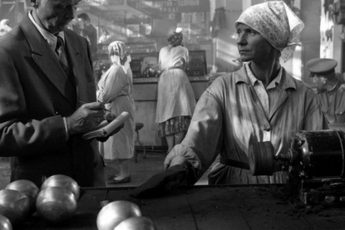The Dawn of Soviet Childhood
Laila Pakalniņa’s Dawn (Ausma, 2015)
Vol. 66 (Summer 2016) by Paulina Duda
What remains after watching Laila Pakalniņa’s Dawn is, above all, the memory of its strikingly arresting photography. The thought, “What was the story about?” does not necessarily come next, as the narrative first needs to be reorganized and pieced together to really make sense. Those who know Sergei Eisenstein’s unfinished film Bezhin Meadow from 1937 (or what is left of it) will have an easier job understanding the movie’s trajectory, as Pakalniņa borrows heavily from that portrayal of the young Soviet hero, Pavlik Morozov.1 Pakalniņa flamboyantly neglects the principles of tight plot and creates (recreates?) the atmosphere of the early Soviet era, rather than merely illustrating one of its tales. And her vision, in contrast to that of many filmmakers from former Socialist republics, has nothing to do with demonizing the USSR. Mediated by Pakalniņa’s sensitivity and Wojciech Staroń’s camera is a vibe that is definitely absurd, slightly cruel but, above all, filled with warmth and even nostalgia.
“Dawn” is the name of a collective farm where a seraphic boy, Janis (Antos Georgs Grauds), denounces his father to the Bolsheviks for opposing the idea of collectivization. In return, the father (Vilis Daudzins) – who already beat his wife to death – decides to take revenge on his son. Luckily, the farm’s charismatic Chairman (Andris Keiss) and a Forewoman (Liena Smukste) manage to arrest the murderous father and a few of his fellows, but the group soon escapes and continues to seek revenge on the little boy. Even the arrival of the farm’s political boss Karlis (Wiktor Zborowski) cannot avert the tragedy: in the end, little Janis dies at the hands of his own father.
Yet, this seemingly self-sufficient “plot” does not function as a typical story would. Rather, it has the structure of a dream, or memory, where transitions between one event and another are bumpy and sudden, and where the location shifts between different spectacular spaces. In fact, it is not really the fate of little Janis (modeled on Pavlik Morozov) that dominates the film. Pakalniņa includes many long panoramic scenes depicting the farm folk: how they ransack the local church, harvest the fields with incredibly synchronized movements of their scythes (reminiscent of a scene from Aleksandar Askoldov’s Commissar, 1967), laugh at the prisoners or paint a giant star on the communal building. The scenes with peasants parallel other long sequences with the local Pioneers, who always seem to hang out in their group, never with their parents. The Pioneers appear as the ideal children of the system, completely absorbed in the flow of their politicized school. There is a clear division between the toothless and wrinkled peasants and the joyful and self-confident children in their snow-white shirts and neck bandanas. They are the future, the film seems to suggest, and they have the executive power. In fact, the boss, Karlis, is not only shown walking around the village and stroking the children (who are everywhere) but is also literally ordered by one little girl to help save Janis.
To be sure, despite its picturesque, dreamy photography and meticulous frame compositions, Dawn is not an uncritical homage to the Soviet era. Pakalniņa points to the many absurdities and cruelties of the Communist regime: Soviet inefficiency is alluded to in a scene where one militiaman is too scared to help a screaming woman. In another scene, the Chairman, wearing a bandage on his head, delivers a passionate ideological speech to the peasants which is met by the local people with long, uncontrolled laughter. The way in which the regime took advantage of human labor is the target of yet another sequence, where the overworked Forewoman reports to her superior Karlis literally while asleep. But Pakalniņa manages to render the scene comical, as the Forewoman declares that nobody could wake her except for the man whose picture hangs on the wall – comrade Lenin.
Pakalniņa thus lightens her story with doses of absurd humor. While we can read Karlis’ appearance at the Forewoman’s household, where he teaches her husband how to clean the house and wash his wife’s feet, as a critique of how the state wanted to penetrate the private sphere of every citizen’s life, the whole scene is more hilarious than condemning. What is more, Karlis, who represents the Communist authorities, is a very pleasant and likeable man who genuinely believes in creating a “classless society”. In the final scene, he takes the body of murdered Janis into his hands and leads the procession of peasants singing “We’ll follow the October flag forever”. Although at first he seems saddened by the young boy’s death, he quickly reassures others that “Leninists don’t recognize this word [death]”. That final scene could speak to Karlis’s coldness, but in fact it is not the real boy whom he carries, but rather his myth, which was really always a piece of propaganda.
One of the reasons why Eisenstein’s production was halted was that he supposedly produced a film of “harmful formalistic exercises”.2 While it is impossible to say whether that was really the reason for abandoning the project or even true of the film, the description certainly does not fit Pakalniņa’s production. For all its dazzling photography, Dawn is not simply a display of somewhat “cold” but striking pictures. The Latvian filmmaker directs the snippets of Soviet reality with a great degree of warmth that stops it from feeling like an exercise in pure cinematic form. A sentence in the credits tellingly reads: “Inspirers: Sergei Eisenstein, Alexander Rzesevskis and Vladimir Putin, and our childhood”. This playful sentence implies that although the Soviet system produced different kinds of people (good and bad, talented and not), all of them share that same memory of growing up under Communism. And that memory, like most childhood reminiscences, is always colorful – even if shot in black and white.




Leave a Comment